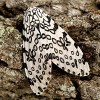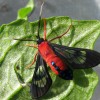 The giant leopard moth is our largest eastern tiger moth. It was formerly in the family Arctiidae, which now composes the subfamily Arctiinae in the family Erebidae. Giant leopard moths are nocturnal. Males are commonly attracted to lights at night. Sometimes dozens of males come to bright lights set out in good habitat. This 6-page fact sheet was written by Donald W. Hall, and published by the UF Department of Entomology and Nematology, August 2014.
The giant leopard moth is our largest eastern tiger moth. It was formerly in the family Arctiidae, which now composes the subfamily Arctiinae in the family Erebidae. Giant leopard moths are nocturnal. Males are commonly attracted to lights at night. Sometimes dozens of males come to bright lights set out in good habitat. This 6-page fact sheet was written by Donald W. Hall, and published by the UF Department of Entomology and Nematology, August 2014.
http://edis.ifas.ufl.edu/in1043
Tag: Family: Arctiidae
Scarlet-bodied wasp moth, Cosmosoma myrodora (Dyar) (Insecta: Lepidoptera: Arctiidae)
 The scarlet-bodied wasp moth, Cosmosoma myrodora (Dyar), is a beautiful native insect. Because of its striking adult coloration, including a bright red thorax and abdomen, and transparent wings patterned with black, this moth immediately stands out in Florida landscapes. Larval feeding is restricted to two native plants in the genus Mikania, family Asteraceae. This 5-page fact sheet was written by Diego Moscoso, Rodrigo Diaz, and William A. Overholt, and published by the UF Department of Entomology and Nematology, May 2013.
The scarlet-bodied wasp moth, Cosmosoma myrodora (Dyar), is a beautiful native insect. Because of its striking adult coloration, including a bright red thorax and abdomen, and transparent wings patterned with black, this moth immediately stands out in Florida landscapes. Larval feeding is restricted to two native plants in the genus Mikania, family Asteraceae. This 5-page fact sheet was written by Diego Moscoso, Rodrigo Diaz, and William A. Overholt, and published by the UF Department of Entomology and Nematology, May 2013.
http://edis.ifas.ufl.edu/in996
Fall webworm, Hyphantria cunea (Drury) (Insecta: Lepidoptera: Arctiidae: Arctiinae) (EENY486/IN878)
This 9-page illustrated fact sheet describes this pest whose larvae form large tents in the foliage of many ornamental trees & shrubs, and also agronomic crops — synonymy, distribution, description and life cycle, hosts, economic importance, and management. Includes references. Written by Andrei Sourakov and Thomson Paris, Published by the UF Department of Entomology and Nematology as part of the Featured Creatures collection, December 2010.
http://edis.ifas.ufl.edu/in878